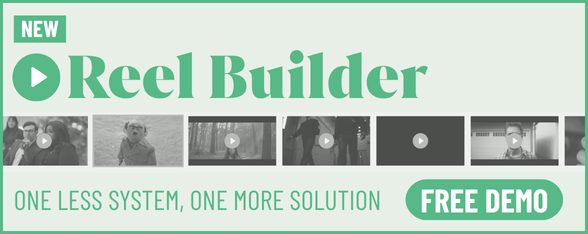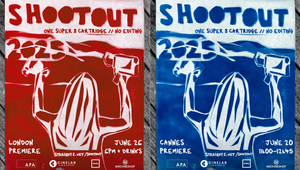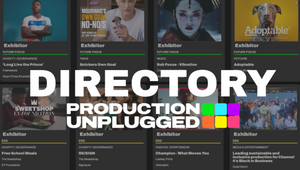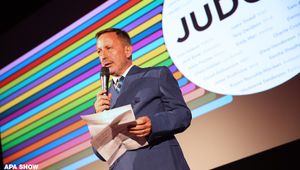
The Future of Advertising: Adless or Adtech?

The Future of Advertising (TFOA), held by the Advertising Producers Association (APA), came back with a bang this year for another afternoon of insight and advice. The event opened with Steve Davies, chief executive of the APA, his words filled with hope and most importantly - his hope that those attending would walk away with new discussions, ideas and innovations in mind for the upcoming year.
With a whopping 30 speakers from all ends of advertising and production, spread across 11 sessions, the afternoon was packed with conversations ranging from bespoke narratives in music, the explosion of VFX, to exploring a screenless future. The sessions kicked off with Andy Nairn, founding partner at Lucky Generals and writer of the book ‘Go Luck Yourself’ exploring the topic of luck and how to be best positioned in its way. “Luck is a great taboo in Western business,” shared Andy. “But it is still a huge part of what we do, and any creative endeavour involves lots of talent, but also quite a big heap of luck. So you need to learn how to maximise your chances of being lucky.”
And although a lot of the time we tend to look down on luck, because it feels ‘primitive and superstitious’, as Andy put it, it can be the difference between failure and success. So, what are the key pillars of placing yourself in luck’s way? According to Andy and his book, it all starts with appreciating what you’ve got - “If you take a moment to appreciate the good, you’re more likely to succeed and be healthy too as an individual. Same thing goes for business. We have gold mines of talent, clients and data under our noses - appreciate them and utilise them.” Next steps are to always look for opportunities outside of the brief you’ve been given (be it in the park, or in a hobby you love) to get the creative juices flowing, and to keep embracing diversity. “You have to turn misfortune into good fortune,” he added, as the line between what is considered ‘lucky’ and ‘unlucky’ can be quite thin. And last but not least - “Make space for serendipity - give yourself a day to experiment and let things happen. As Quincy Jones said, leave space for the Lord to walk through the room. This is when best ideas take off.”
After an uplifting conversation, Chris O’Reilly, co-founder and CCO at Nexus, took the stage to talk about welcoming the power of real-time content, from the viewpoint of one of the frontrunners in the space. “Real time is opening the door to entirely new creative opportunities for brands and storytellers,” said Chris. He used the well-known Nexus flower graph, with a case study of Gorillaz, a current client of the company, to explain all the branches in which real time can make a difference. With the Gorillaz IP in the centre of the flower, real-time content branches out to OOH (the concert Nexus placed for the band at Times Square), social media, film and TV, branded content, real-time powered interactions with fans and immersive experiences.
“Real time opens the door to doing a lot in the animated spaces with so many brands and platforms. We set up ‘Murdoc’s Mixology Class’ with Smirnoff through real time. We had him responding to fan theories on Instagram, which changes the tonality of fan communication a lot. When brands are online, it can many times feel like somebody wearing a tuxedo to a fast food restaurant. Real time can change that with its huge scope for improvisation.” Not only this, but the assets can be moved too. What Gorillaz did when they towered over Times Square - that can be easily placed into Fortnite, to give users an entirely new experience.
Which brings us to ownable content and its new opportunities with Ollie Allgrove, executive producer and co-founder at long form development company Two Flying Fish. “This brand IP (the Gorillaz IP at the centre of the flower) that Chris spoke about can also be applied in live action,” he said. “You need to try to get your whole company to think about where something can come from that is ownable. Often we might think this will come from our directors roster, but it remains true that in the world of broadcast, the director is not king - the producer is.” His approach when going to a new company is to set up a creative session with everybody where they think and discuss what that culture of brand IP might be - is it documentary, character animation, or something entirely different? “And once you decide to launch, you have to slowly start baking this into the culture of your content.”
The conversations on stage then moved on to bespoke narratives and getting creative with music artists, led by Rachel Menzies, vice president, bespoke services at BMG, Mark Levin, vice president - Sync - creative and commercial at BMG, Joe Innes, sync creative manager at BMG UK, and Commie McMullen, executive creative director at Big Sync. Their conversation explored the emergence of ever more touchpoints for brands and artists alike, creative partnerships between the two and how they are becoming an increasingly important mechanism for truly engaging with consumers.
When talking about the state of Sync, the panel agreed that, in a nutshell, when considering music for your production you go through one of three routes: licensing an existing track, commissioning someone (often a media composer or artist), or licensing a production music track where the direction is determined by a number of factors - budget and timing among others.
Joe explained that lately, the market for Sync has been interesting, with the trend being that audiences respond better to familial songs and seem to be moving away from risk, which reflects to him a wider trend in music - familiar samples being remixed, reinterpreted and reemerging. Mark agreed: “If a song has been used by a competitor, things can fall apart. But there are some evergreen songs that get used and reused all the time. Our job is to create something new with them, while also reworking, covering, remixing and making something familiar yet bespoke. Grab a stem from an older track and work with another amazing artist to create something new.”
Commie added that, at large, TikTok has also been hugely beneficial for the music business, as it has helped for digital to move from a ‘sound off’ to a ‘sound on’ media space, which has suddenly insentivised all clients to engage with music. “Particularly the beauty brands,” Commie said. “The jingle is back! Apart from using commercial sounds that are trending, a lot of clients are trying to create bespoke music and a lot of the time that’s a classic ‘40s jingle. Reaching out to gen z is a big push here, which also affects the overall sonic strategy of a brand.”
Next up, the stage opened the green transition conversation, by calling it ‘Humanity’s greatest ever production’ with Leo Rayman, CEO and founder of EdenLab. Leo spoke about the incredible scope of influence that production could have on popular culture, especially when they can help brands grow but ‘not by hitting them with a stick’ - something he believes activism has failed at. Leo took Tui and Unilever as examples of brands that are going above and beyond for their own green transitions.Instead of showing the audience the devastating impact of climate change should they not act, he resorted to showing them the immense growth that brands like Tui and Unilever have experienced as a result of turning green.
“Tech firms that grow much faster are those into the climate. IKEA - the more they become climate conscious, the more they sell. The charts prove it’s the only right thing to do. And I’m not here to talk to you about the moral reasoning, because I should think that’s a given. I am giving you the business reasoning,” said Leo.”It is going to become huge in the coming years, and I’m willing to bet my career on it.”
He continued, “The moment that is happening now is the same one as the one that happened ten years ago when a lot of people didn’t quite get digital and are now finding it quite hard to get jobs.” Besides the fact that talent is increasingly more keen to work with planet conscious companies, Leo explained that only marketers, producers and advertisers have the power to sell climate consciousness as only they know it - by betting on better prices, better quality and not guilt tripping audiences into switching to green habits. “The activists don’t know how to attract people - but you do. You can tell clients how to do stuff right. You can attract people. Use that power wisely and work with people where you are absolutely sure you’re not greenwashing.”
The next panel explored the explosion of VFX and what comes after it with quite a few participants on the stage - Darren O’Kelly, CEO at Untold Studios, Ellora Soret, executive producer at Company3, Helen Stanley, head at The Post Arm, Leonie Moreton, managing director at Coffee&TV, Jim Allen, creative director at No.8, Jon Purton, managing director at ETC and Sean Costelloe, managing director at Selected Works. The post and VFX commercial landscape has undergone a huge revolution. After six brilliant, big companies dominated the market for 25 years, we’ve now seen an explosion of new, smaller companies, each capable of doing the biggest and best post and VFX productions and producing great work. So why has this happened and what does it mean for those seeking post and VFX expertise?
Leonie explained that software becoming more accessible has democratised the space of post immensely and allowed people to enter it with the hopes of doing things differently. “The artists that join us now are interested in purpose and want to align with their company’s values.” For Jon, the pandemic ultimately accelerated things as well. “People became more retrospective and started their own companies. There was an erosion around the idea that you need to be in a good company to make good work.”
According to Sean, things have also changed in terms of what people expect from their workplace. “There was a push for a stronger bond between clients and artists, which paved the way for smaller companies to get more work. Technology is a huge part of it - before, you needed a lot more to open a VFX company, now a lot more investors look in the way of smaller companies.” And it remains true that today, talent is available everywhere - not just in the big guys.
Looking forward, the panel agreed that the future is bright and there has never been a more democratic opportunity for young people to enter the industry, nor more content being made.
After a short break, Eliot Liss, head of production at IPA, Lorraine Warner, senior regional advertising producer for Europe at Unilever, Juliette Larthe, co-founding partner and executive producer at PRETTYBIRD UK, Melda Simon, UK lead for the Unstereotype Alliance at UN Women, and Virgilia Facey, co-founder and business director at Gather took the stage to talk about the diversification of the talent supply chain, with a focus on what happens behind the scenes.
For Juliet, the most important thing is attitude, and keeping the same attitude regardless of whether it’s work is purpose-led or not - it needs to seep into the culture of the entire industry. “It is an enabler, but also a barrier,” she said. “It’s a game changer when done right. On the flip side, it can ruin things when people say ‘No we can’t have diversity here because we want to give it to this award-winning director’.” This is why, explained Loraine, at Unilever, all scripts are anonymised with no agency recommendation - this enables the brand team to go in cold, see who they like and have a conversation about it. Then, another level is added, where Unilever gives each of the directors 20 minutes of brand time to have a conversation with them - “Everyone on that pitch process has a completely equal chance of getting it.”
Juliette added that now is the time to persuade people to go with the ‘less safe’ options, which takes a village. “We work in film, so there is no one single person responsible for the entire thing. Often we credit just the individual, but it is very much a team effort - we sometimes forget that when it comes to helping the outsider win the job.” The panel also agreed that, while there is no such thing as a solid ‘safe option’, agencies are the conduit - a lot can flow from having a diverse range of people writing the creative, so agencies need to facilitate what production companies need to do to improve the process.
Casting briefs and casting processes alike need to change. “If you are holding your casting in a Soho building up three flights of stairs in the middle of a working day, you are most likely to get a very certain group of people,” said Eliot. This is why the IPA has come up with a new casting brief which addresses the need for inclusion and condemns the specification of ethnicity, gender, sexuality, age on a script where they are not relevant.
Next up, Jen Bechard, head of production for Creative Lab Europe at TikTok and Neil Boorman, head of Creative Lab Europe at TikTok discussed how adland can make ads that use TikTok better. Key things that should be discussed with clients immediately came up - you need to know your client’s budget, media spend and production spend. Following that, you need to understand the formats. From TopView, in-feed ads, hashtag challenges and others, those are the formats that you should be playing with when advertising on TikTok.
While seemingly complicated, Jen explained that the formats are quite flexible, allowing you to vote on stories and overall encouraging interaction between brand and viewer. One important thing to remember is that TikTok, as of current, is a very ‘test and learn platform’. So, once you’ve familiarised yourself with your formats and chosen the best suited ones for you, you need to know where they run - carrousels, gesture ads, all sorts of new stuff come and go based on success. So, more than anything, make sure that the formats and trends you’re pitching exist and are doing well in the market you’re pitching for.
Speaking of TikTok and its ever-increasing usage by brands, this conversation paved the way for a peek at the future of advertising, what it looks like, and most importantly - whether it’s adless or full of personalised ads. When technology, data, media, and creativity are all rapidly evolving to create a future where perfectly personalised content will be delivered unobtrusively to consumers across platforms however they want it - no interruptions, no selling, no jingles. Is this the future of advertising? Carsten Thode, CEO and co-founder of Aphetor, Janet Markwick, former global VP of commercial operations at Technicolor and founder and CEO of Markwick consulting, Matt Willifer, chief strategy officer at Carat UK, Nils Leonard, co-founder at Uncommon, Rhona Glazebrook, founder at RG Comms Services, and Jessica Ringshall, chief production officer at Saatchi & Saatchi took the stage to discuss.
Carsten, coming from a 20-year-long background in sports, explained how that sector is finding it increasingly difficult to reach a younger audience, mainly because the entire commercial ecosystem of sport is built around live TV. “This is the first generation for which the TV is not the centre of their media consumption universe,” he said. “How do we give them sport on their terms - their channels, their devices, their preferred ways of communication?” He continued, “We need to give them content in their preferred ways, and the question for brands is how do you show up in that content in an authentic way, not with your logos plastered on it.” This has the potential to, according to Carsten, create an incredibly diverse ecosystem of communication, across platforms like TikTok, B-Real, YouTube and others.
Matt took a slightly different course, explaining that traditional advertising such as AV and OOH, or interruptive advertising, is still ‘very much alive and well’. “They’ve morphed in numerous ways of course, but they are still hugely effective,” he said. “So from a production point of view, you need to be aware of how these traditional modes of advertising have evolved and morphed in the modern world.” His example was AVs which evolved from non-skippable, to skippable, to partial view on news feeds which you rush past and remind more a digital poster. “The two routes are - get better at interrupting people, or just don’t interrupt people. The difficulty and opportunity is that there are an infinite number of ways to do that.” For Jess, in the ever fragmented production landscape, where clients are sometimes resorting to in-house production, the power that production companies hold is in their unique connection with culture. This remains true in Nils’ words: “Production companies are simply cooler than most agencies in London.”
The last two talks of the afternoon both looked at two new tech developments that are likely going to spin advertising on its head - AI and AR. The AI conversation, led by Anna Poulter-Jones, associate at The Interactive Group and media and technology lawyer at Sheridans and Jamie Smith, partner at The Interactive Group, spoke about the importance of embracing AI while making sure we fully understand the scope to which the law has progressed alongside them. Training teams and understanding legislation are only the beginning, and are the future of a world where AI will only be getting smarter.
Similarly, Andy Hopkinson, head of production and Perry Mason, head of digital at Territory Studio, believe that technology and innovation are what drives trends and influence in motion design, as well as in film. While they spoke about the remaining resistance of the general public to meta worlds, they also explained how alternative reality could be a layer on top of our own, rather than a separate experience. “In virtual reality creation, anchoring the experience in something already preexisting is the smartest way to go,” said Andy. “For example, if you’re creating a virtual layer of reality on top of your car’s interface, you would probably also use the same hand gestures as the ones you would on a phone - pinching for zooming out, etc. This isn’t alternative, it’s a mixed reality. If VR is replacing your world, this digital layer allows you a two-way communication with itself.”
So, whatever the future of advertising may hold, one thing is certain - things keep accelerating, especially on a technological level, which tears down conventional food chains that traditionally have worked. By next year, we may see branded AI robots, or a totally screenless experience… or TikTok will have us all glued to the screen more than we have ever before. One thing is certain - whatever you do, do it green.













